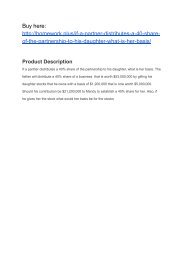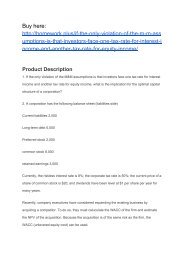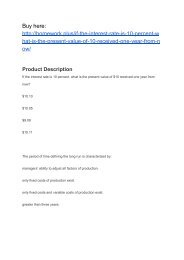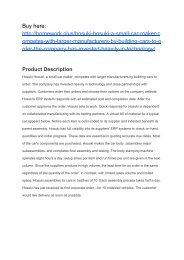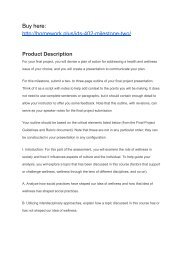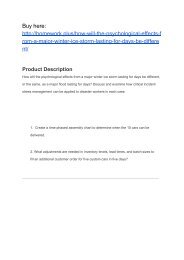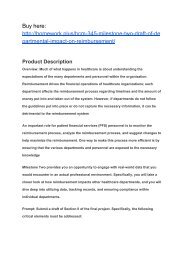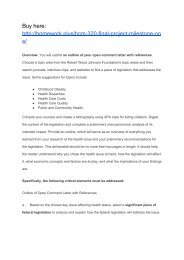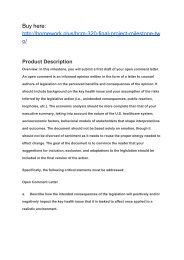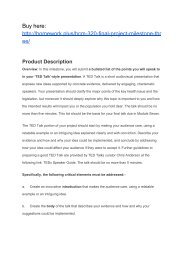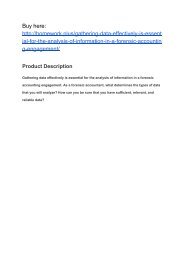You also want an ePaper? Increase the reach of your titles
YUMPU automatically turns print PDFs into web optimized ePapers that Google loves.
Buy here:<br />
http://homework.plus/fin-<strong>644</strong>-exam-1-<strong>solutions</strong>/<br />
Product Description<br />
<strong>FIN</strong> <strong>644</strong><br />
<strong>Exam</strong> 1<br />
Name___________<br />
1. Consider the following balance sheet and income statement data for Landmark<br />
International, figure out the cash profit of the company:<br />
Balance Sheet 12/31/03 Balance Sheet 12/31/04<br />
Cash $200 $550<br />
Accounts receivable $800 $700<br />
Inventory $250 $150<br />
Fixed assets $1,000 $1,000<br />
(Accumulated depreciation) ($400)<br />
($600)
Total Assets $1,850 $1,800<br />
Accounts payable $200 $250<br />
Operating accruals $300 $150<br />
Debt $750 $395<br />
Common stock $400 $400<br />
Retained earnings $200 $605<br />
$1,850 $1,800<br />
Income Statement for the year ended 12/31/04<br />
Sales $4,500<br />
COGS 2,200<br />
Gross Profit $2,300<br />
Operating expenses 1,300<br />
Depreciation<br />
200<br />
Operating profit $800
Interest 75<br />
Taxes<br />
320<br />
Net Profit $405<br />
Dividends<br />
0<br />
Addition to retained earnings $405<br />
2. If a firm has purchases of $50,000, a starting inventory of $35,000 and the cost<br />
of goods sold is $45000, what is the dollar amount of its ending inventory?<br />
The following financial data are to be used for questions 3-7:<br />
2000 2001<br />
Cash & equivalents $25 $75<br />
Accounts receivable $450 $700<br />
Inventory $400 $500<br />
Gross Fixed assets $1,000 $1,000<br />
(Accumulated Depr.) ($200) ($250)<br />
Total Assets $1,675 $2,025
Accounts payable $100 $200<br />
Notes payable $50 $275<br />
Operating accruals $60 $55<br />
Current maturities $50 $50<br />
Long-term debt $400 $382<br />
Shareholders’ equity $1,015 $1,063<br />
Total Liabilities & Equity $1,675 $2,025<br />
2000<br />
2001<br />
Revenues $1,500 $2,250<br />
COGS $750 $1,125<br />
Operating expenses $700 $750<br />
Depreciation $100 $50<br />
Interest $40 $45<br />
Taxes $(36) $112<br />
Net Income $(54) $168<br />
Dividends $45 $120
3. What is the 2000 quick ratio?<br />
4. What is the 2000 working capital requirement to sales ratio?<br />
5. What is the 2001 cash conversion efficiency?<br />
6. How long is the 2000 cash conversion period?<br />
7. What is the 2001 sustainable growth rate?<br />
8. Torque Manufacturing forecasts that its production will require 500,000 tons of<br />
bauxite over its planning period. Demand for Torque's products is stable over time.<br />
Ordering costs amount to an average of $20.00 per order. Holding costs are estimated<br />
at $1.25per ton of bauxite. What is the EOQ for Torque?<br />
The following information is to be used for questions 9-12:<br />
Lott Manufacturing Inc. has been ordering parts for its production process in lots of<br />
10,000 units. Each order cots the firm $50 to place, and holding costs per unit average<br />
$3. Lott uses 200,000 units every 250 days.<br />
9. EOQ for Lott is?<br />
10. Given the EOQ you calculated for Lott, how many orders should be placed and<br />
what is the average inventory balance?<br />
11. If it takes 2 days to receive an order from suppliers, at what inventory level<br />
should Lott place another order?<br />
12. If Lott was recently been approached by its supplier with a new quantity<br />
discount program, and Lott determines that the optimal order quantity is 4,000 units,
and at this level of order inventory, the company will pay $4.98 per unit. Determine the<br />
total inventory costs for Lott considering the quantity discount.<br />
13. A company purchased inventory worth of $2280 in March. At the end of March<br />
it had inventory balance worth $456. Calculate March balance fraction.<br />
14. Credit analyst John Adams is considering a $1,000 order from a new customer.<br />
The cost of filling the order is $950. John estimates collection costs are $20. The<br />
customer will pay in 60 days. If the appropriate cost of capital is 18%, what is the NPV<br />
of extending credit to the new customer?<br />
15. A credit analyst has received a $10,000 order from a new customer. The cost of<br />
filling the order (i.e., COGS) is $8,000 and collection costs are $200. The credit analyst<br />
notes that the COGS will be paid immediately. Further, it is assumed that the<br />
customer will repay the trade credit obligation in 60 days. It is also assumed that the<br />
collection costs will be incurred in 60 days. If the appropriate discount rate is 8%,<br />
what is the NPV of extending credit to the new customer?<br />
16. A credit analyst has receiveda $20,000 order from a new customer. The cost of<br />
filling the order (i.e., COGS) is $19,100 and collection costs are $500. The credit<br />
analyst notes that the COGS will be paid immediately. Further, it is assumed that the<br />
customer will repay the trade credit obligation in 90 days. It is also assumed that the<br />
collection costs will be incurred in 90 days. If the appropriate discount rate is 10%,<br />
what is the NPV of extending credit to the new customer?
17. East Stores has derived the following consumer credit scoring model:<br />
Y=0.2*Employment + 0.4*Homeowner + 0.3*Cards<br />
Employment=1 if employed full time, 0.5 if employed part-time, and 0 if unemployed;<br />
Homeowner=1 if homeowner, 0 otherwise<br />
Cards=1 if presently has 1-5 credit cards, 0 otherwise<br />
The store determines that a score of at least 0.7 indicates a very good credit risk, and<br />
it will extend credit to the individuals. If Janice is employed half time, is a homeowner,<br />
and has 2 credit cards at present, does the model indicate she should receive credit?<br />
18. Emily Cheney is evaluating a proposal to extend credit to a group of new<br />
customers. The new customers will generate an average of $40,000 per day in new<br />
sales. On average, they will pay in 68 days. The variable cost ratio is 80%, collection<br />
expenses are 2% of sales, and the cost of capital is 10%. What is the NPV of one day's<br />
sales if Emily grants credit? Assume that there is no bad debt loss.<br />
Use the following information for questions 19-21.<br />
Your firm’s CFO has tasked you with evaluating the net present value associated with<br />
changing the firm’s trade credit terms from net 30 days to net 45 days.Other pertinent<br />
assumptions include:<br />
Annual sales with existing credit terms = $5,000,000
Variable cost ratio with existing credit terms = 30% of revenues<br />
Costs of collections with existing credit terms = 1% of revenues<br />
Bad debt expense ratio with existing credit terms = 2% of revenues<br />
Annual sales with new credit terms = $5,500,000<br />
Variable cost ratio with new credit terms = 30% of revenues<br />
Costs of collections with new credit terms = 1% of revenues<br />
Bad debt expense ratio with new credit terms = 3% of revenues<br />
Discount rate = 10%<br />
19. What is the daily net present value of the current trade credit policy? Assume<br />
that the variable costs are paid upfront while the costs of collections occur when the<br />
payment is received from the customer.<br />
20. What is the daily net present value of the new trade credit policy? Assume that<br />
the variable costs are paid upfront while the costs of collections occur when the<br />
payment is received from the customer.<br />
21. What is the aggregate increase in net present value from making this change to<br />
trade credit policy?<br />
22. What is the optimal cash discount percentage with the following financial<br />
situation: Cash discount period=10 days, credit period=30 days, and annual cost of<br />
capital=22%.
23. Besley Inc., manufactures and sells wallboard for use in construction of<br />
modular homes. It sells on net 30 terms to contractors. Following are the last 6<br />
months’ sales and the A/R balances at the end of June, the present (report) month.<br />
Calculate the uncollected balance percentages for this company.<br />
Accounts Receivable Schedule; June 30<br />
Month* Credit Sales Uncollected Amount<br />
January $ 75,000 $ 5,000<br />
February 50,000 5,000<br />
March 100,000 6,000<br />
April 40,000 6,000<br />
May 45,000 8,000
June 50,000 12,000<br />
June 30 A/R balance $42,000<br />
1. * assume all months have 30 days



